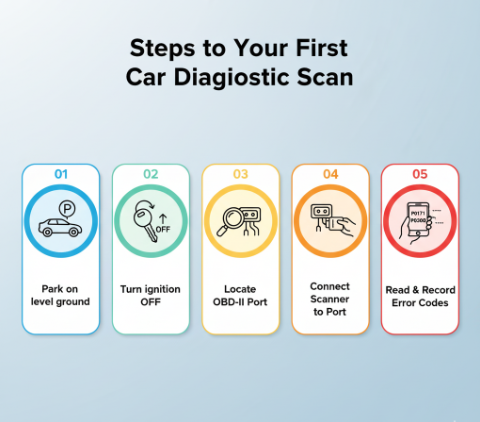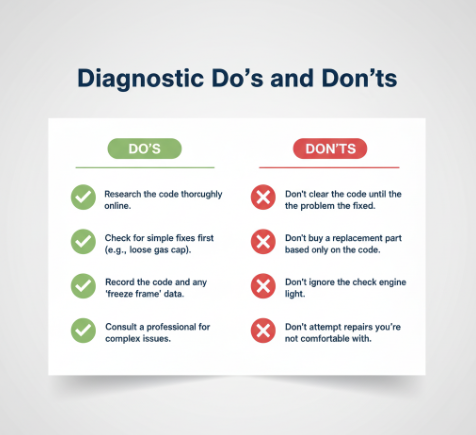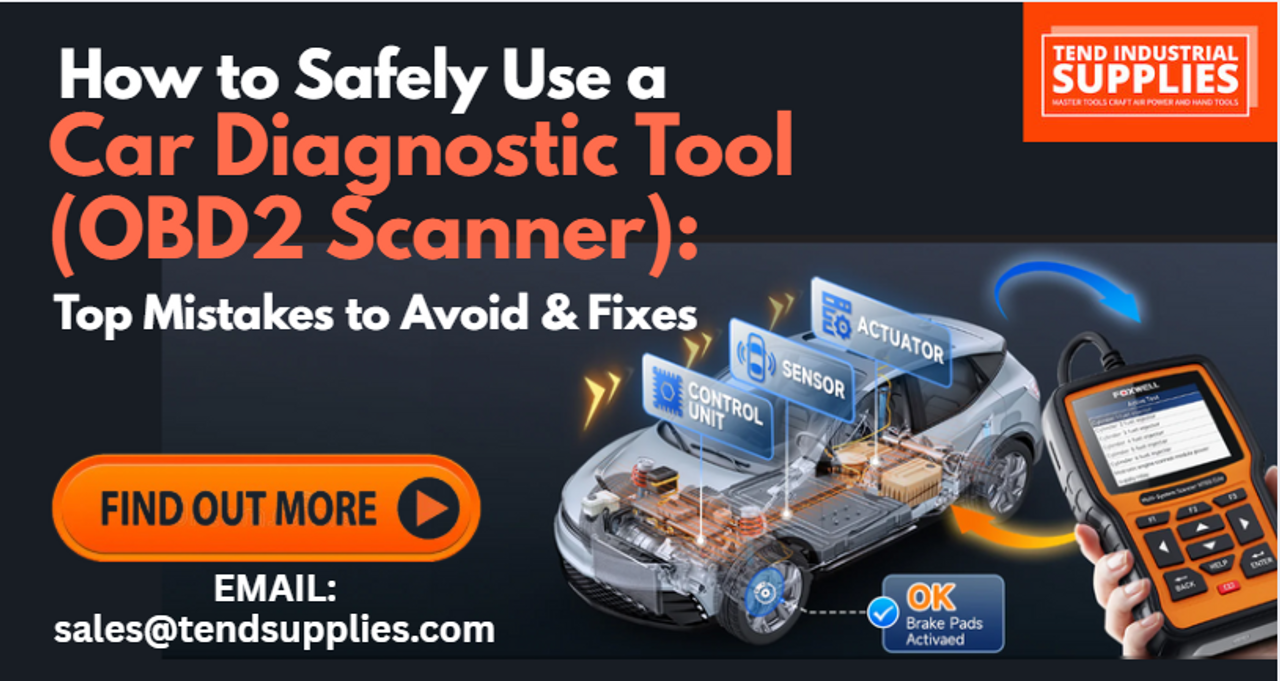How to Safely Use a Car Diagnostic Tool (OBD2 Scanner): Top Mistakes to Avoid & Fixes
When that dreaded check engine light flickers on, many drivers rush to the mechanic without realizing they can take the first step themselves. A car diagnostic tool, also known as an OBD2 scanner, is a powerful device that helps you uncover hidden issues in your vehicle before they become expensive repairs. But here’s the catch—using an OBD2 scanner incorrectly can lead to confusion, misdiagnosis, or even overlooking serious problems.
In this guide, we’ll break down how to safely use a car diagnostic tool, highlight the top mistakes drivers make, and share simple fixes so you can confidently keep your vehicle in top shape.
Key Takeaways
- Safety First, Always: Before plugging in the scanner, ensure your car is parked on a level surface with the parking brake on and the ignition completely off to prevent electrical surges or accidents.
- Never Clear a Code Prematurely: Resist the urge to immediately erase a trouble code. Doing so deletes important "freeze frame" data that is crucial for a professional mechanic to accurately diagnose the root cause of the problem.
- A Code is a Clue, Not a Conclusion: Understand that a Diagnostic Trouble Code (DTC) points to a symptom, not the specific faulty part. For example, a "lean" code could be caused by anything from a vacuum leak to a faulty sensor, requiring further investigation.
- Research and Inspect Before Buying Parts: After noting the code, research its common causes online and perform a simple visual inspection for obvious issues like a loose gas cap, cracked hoses, or disconnected wires before spending money on parts.
- Know Your Limits and When to See a Pro: While a scanner empowers you to handle simple fixes, always leave complex repairs involving critical systems like airbags, brakes (ABS), or the transmission to a qualified mechanic.
First, What Exactly is a Car Diagnostic Tool?
Think of it as a translator for your car. Since 1980, most vehicles globally have been equipped with an On-Board Diagnostics (OBD-II) system. When this system detects a fault, it generates a specific Diagnostic Trouble Code (DTC) and illuminates the check engine light. An OBD-II scanner is a handheld device that plugs into your car’s OBD-II port to read these codes, giving you a starting point for figuring out the problem.
The Pre-Scan Safety Checklist: Before You Plug In
Safety first! Rushing this process can lead to accidents or electrical issues. Follow these steps before every scan.
1. Park on a Safe, Level Surface
Always park your car on flat ground, away from traffic. Engage the parking brake. This is crucial for your safety, especially if you need to look under the car later.
2. Turn the Vehicle Completely Off
Ensure the engine is off and the key is out of the ignition before you connect the scanner. Plugging the tool in while the car is running can sometimes cause a power surge, potentially damaging the scanner or your car's Engine Control Unit (ECU).
3. Locate Your Car’s OBD-II Port
The port is almost always located in the driver's cabin, usually under the dashboard near the steering column or pedals. In some cars, it might be hidden behind a small panel. If you can't find it, a quick search online for your car model (e.g., "Toyota Corolla 2010 OBD-II port location") will help.

Infographic Showing 5 Steps to Your First Scan
Common (and Costly) Mistakes to Avoid
Now that you're ready to scan, let's cover the most common pitfalls that many car owners fall into.
Mistake #1: Immediately Clearing the Code
The most tempting button on any scanner is "Erase" or "Clear Code." Do not press it! Clearing the code without fixing the underlying issue does not solve the problem. The light will inevitably return, and you've erased valuable "freeze frame" data that a professional mechanic could use to diagnose the issue more accurately.
Mistake #2: Taking the Code as the Final Answer
A trouble code is a symptom, not a diagnosis. For example, a code like P0171 - System Too Lean doesn't automatically mean you need a new oxygen sensor. This long-tail keyword is a common query. The actual cause could be a vacuum leak, a dirty mass airflow sensor, or a weak fuel pump. Always use the code as a starting point for further investigation.
Mistake #3: Ignoring Your Car's Manual
Your vehicle's manual is an invaluable resource. It contains manufacturer-specific information that can provide context for certain trouble codes. Don't rely solely on generic online advice.
Mistake #4: Performing Repairs Beyond Your Skill Level
It's great to handle simple DIY fixes like changing an air filter or cleaning a sensor. However, issues related to the transmission, airbags (SRS), or complex electrical systems are best left to the professionals. A botched DIY repair can be much more expensive to fix than the original problem. If the codes point to something complex, it's time to find a reliable mechanic.
Mistake #5: Draining Your Car Battery
Some advanced scanners, especially Bluetooth models that pair with your phone, draw power from the car. Don't leave the scanner plugged in for hours or days with the engine off, as it can slowly drain your battery. Unplug the tool once you are finished with your diagnosis.

Infographic Showing Diagnostic Do's and Don'ts
You Have the Code. What's Next?
Reading the code is just the first step. Here's how to proceed intelligently.
1. Write Down the Code and Do Your Research
Note the exact code(s) that appear. Use trusted online resources, forums for your specific car model (like Toyota or Mercedes-Benz), and YouTube to understand what the code means and its common causes. Searching for "how to fix code P0420 on a Honda Accord" will yield more specific results than a generic search.
2. Inspect for Obvious Issues
Before buying parts, do a visual inspection. Look for cracked hoses, loose connections, or frayed wires around the engine component mentioned in the code's description. A common cause for an evaporative emission code is simply a gas cap that wasn't tightened properly.
3. When to Visit a Professional Mechanic
A diagnostic tool makes you a more informed car owner, not necessarily a master technician. You should book an appointment with a mechanic if:
- The codes point to critical systems like brakes (ABS), airbags (SRS), or transmission.
- You see multiple, unrelated codes.
- The issue requires specialized tools you don't own.
- You've tried the simple fixes and the light is still on.
By showing your mechanic the specific code you found, you can prevent them from starting their diagnosis from scratch, potentially saving you time and money on labour.
Frequently Asked Questions (FAQs)
- What does a car diagnostic tool actually tell me?
A diagnostic tool, or OBD-II scanner, acts as a translator for your car's computer. It reads the specific Diagnostic Trouble Code (DTC) that caused your "check engine" light to turn on, giving you a starting point to understand the potential issue.
- Will any OBD-II scanner work on my car?
Most vehicles manufactured since 1996 are equipped with a standard OBD-II port. While most scanners are universally compatible with this system, it's always a good practice to check the scanner's specifications to ensure it supports your specific car make and model.
- Is it okay to clear the check engine light myself after reading the code?
You should avoid this. Clearing the code erases important "freeze frame" data that a mechanic can use to diagnose the problem accurately. The light will almost certainly return if the underlying issue isn't fixed, and you will have lost valuable information.
- If the scanner gives me a code for an oxygen sensor, should I just buy a new one?
Not necessarily. A trouble code is a symptom, not a final diagnosis. A code for an oxygen sensor could be caused by a vacuum leak, a faulty fuel pump, or a dirty mass airflow sensor. Always investigate further or consult a professional before buying parts.
- Can I damage my car's computer (ECU) by using a diagnostic scanner?
While rare, it is possible. To minimize risk, always make sure the vehicle's ignition is completely off before you plug the scanner in or unplug it. This helps prevent any potential electrical surges that could damage the ECU or the tool itself.
- My scanner is a Bluetooth model. Can I just leave it plugged into the port?
It is not recommended. Leaving a scanner, especially a Bluetooth one that is constantly active, plugged in for extended periods can slowly drain your car's battery. It's best to unplug the device once you have finished your diagnosis.
- When should I stop diagnosing and just take my car to a mechanic?
You should always consult a professional mechanic if the codes point to critical systems like airbags (SRS), brakes (ABS), or the transmission. Additionally, if you see multiple unrelated codes or if you've tried the simple, obvious fixes and the light remains on, it's time to see a pro.
- How does telling my mechanic the code I found actually help me?
Providing the mechanic with the specific code you found gives them a valuable head start on the diagnosis. It can save them time, which in turn can save you money on labour costs, and it helps you have a more informed conversation about the necessary repairs.
Related Articles:
- What is a Car Diagnostic Tool? Your Ultimate Guide to Saving Time & Money
- The Ultimate Guide to Buying a Car Diagnostic Tool (OBD2 Scanner)
- Check Engine Light Codes Explained: P0420, P0300, P0171 & More (DIY Fixes & Costs)
- The 5 Must-Have Diagnostic Scanners for Professional Mechanics in 2025
- Basic vs. Advanced: What's the Difference Between a Code Reader and a Professional Scanner?
Conclusion
A car diagnostic tool is far more than just a gadget; it’s an essential key to modern vehicle ownership. By mastering how to use an OBD-II scanner at home, you replace the uncertainty of a check engine light with clear, actionable information. The real skill lies not just in pulling a code, but in what to do after reading a car trouble code. By treating the code as a starting point for investigation, avoiding the common mistake of clearing it prematurely, and knowing when an issue requires professional help, you shift from being a reactive driver to a proactive owner.
Ultimately, this device empowers you to have more intelligent conversations with your mechanic and make smart car repair decisions that protect both your vehicle and your wallet. You stop guessing and start diagnosing, turning a moment of stress into an opportunity for control.
Call to Action
Ready to Take Control of Your Car's Health?
Stop guessing and start diagnosing. A reliable OBD-II scanner is the best investment you can make to save money on costly repairs and have confident conversations with your mechanic. Find the perfect tool for your vehicle and budget in our curated collection.
- Shop Our Full Range of Scanners: Tendsupplies.com
- Have a Question or Need a Bulk Order? Email our expert team at sales@tendsupplies.com for personalized advice and quotes.








